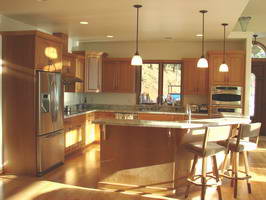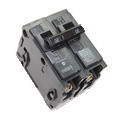Adding Circuits to an Electrical Panel
 '; ';
|
How do I add new circuits to my electrical breaker panel for new equipment that I will be installing? Evaluating the Electrical Load Capacity of a Panel, Identify Circuit Requirements. © By: Dave Rongey |
Guide to Electrical Circuits and Panel Loads
Electrical Question: How do I add new circuits to my electrical breaker panel for new equipment that I will be installing?
- I have a 2pole 40 amp circuit breaker supplying power to my shop. The panel in the shop has 4-15a.single pole breakers supplying power to 6-15a electrical outlets and 9-4 bulb florescent fixtures.
- With these I also have1-2pole-15a. breaker for the heater and last but not least 1-2pole-20a breaker that is open for use.
- How do I hook up a 220volt 12 amp table saw and a 220volt 15 amp joiner and staying with the 40amp 220volt supply into the shop coming from the house.
Anny Ideas?
This electrical wiring question came from: William, a Homeowner from Langley British Columbia, Canada.
Additional Comments: Very informative I am glad I found! Thank you.
Dave’s Reply:
Thanks for your electrical wiring question William.
How to Add Circuits to an Electrical Panel
Application: Adding Circuits to a Panel.
Skill Level: Intermediate to Advanced – Best installed by a Licensed Electrical Contractor.
Tools Required: Basic Electricians Pouch Hand Tools, electric drill, auger bits and extension cord.
Estimated Time: Depends on personal level experience, ability to work with tools and install electrical circuit wiring.
Precaution: Identify the panel circuit, turn it OFF and Tag it with a Note before working with the wiring. Working in electrical panels is dangerous and not recommended for unqualified individuals.
Notice: Installing additional circuit wiring should be done according to electrical codes, with a permit, and all work should be inspected by the local building authority.
Electrical Circuits and Panel Loads for Your Home Workshop
Hi William, sure – I have some ideas and thoughts about this, let me break it down for you.
- Evaluating the Electrical Load Capacity of a Panel
What we need to understand is that just because there may be a lot of existing circuit breakers, this does not mean that everything will be used at the same time, especially if you are the only one that will be working in the shop. - Now there are some things that may be controlled automatically that you would need to consider.
- Things like using a space heater on a cold day and the possibility that the space heater may come on at the same time as the table saw for example.
- The main factor is to first understand the maximum allowable load or amperage that the panel is capable of providing, in this case it is 40 amps 240 volts.
- Identify Full Load Requirements
Keep in mind that you do not want to load any circuit to the full capacity, in fact 80% circuit load is ideal. - Then make a list of all the existing circuit loads which would include the actual watts or amps of each the electrical devices.
- Then really think about what items will be actually used at the same time. Now see what your available load capacity is.
- Then you need to see if you have the physical space available to add more circuit breakers.
- Keep in mind that your brand of panel may have twin circuit breakers or quad circuit breakers available which may create needed space, but this depends on the brand and type of panel that you have.
- Here is an Electrical Tip for Workshops and Garages with Motorized Equipment
- When possible, provide 220/240 volt power to equipment such as table saws, air compressors, etc.
- Check to see if these types of equipment are dual voltage or 120/240 volts.
- Understand that the motor connections will most likely need to be adjusted for the change in voltage and the receptacle and plug must be changed for the voltage and amperage as required.
- The advantage is that the equipment will run much better and may be more efficient as well, which could actually save you on your electric bill because the electrical load will be closer to being balanced between the 240 volt power lines.
Basic Electrical Calculations Based on OHM’s Law
- Electrical load calculations are as follows:
- Watts equal the voltage times amperage.
- Amps equal watts divided by the voltage.
- NOTE: Remember to keep the circuit load below or at 80% of the circuit capacity.
More about Electrical Circuit Wiring
Electrical 120Volt Outlet Wiring
-
Wiring Electrical Outlets for the Home
- Home electrical wiring includes 110 volt outlets and 220 volt outlets and receptacles which are common place in every home. See how wiring electrical outlets for the home are done.
-
House Wiring Circuits and Circuit Breakers
- This article looks at common 120 volt and 240 volt house wiring circuits and the circuit breakers that are installed identifying the types and amperage sizes used in most homes.
-
Home Electrical Circuit Breakers
- A guide to home electrical circuit breakers and how they work to protect your electrical wiring. When properly installed, your home electrical wiring is protected by a circuit protection device.
The following may also be helpful for you:
|
|
Be Careful and Be Safe - Never Work on Energized Circuits!
Consult your Local Building Department about Permits and Inspections for all Electric Wiring Projects.
More articles about Adding Circuits, Electrical Wiring and Home Electrical Wiring: |
|
| « Previous | Next » |
Why Circuit Breaker Keeps Tripping Off |
How to Replace a 3 Way Switch with a 3 Way Dimmer Switch |

















